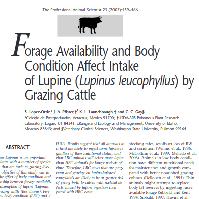Resumen
-
The genus Lupinus is an important group of plants with a number of species worldwide that are toxic to grazing livestock. The objective of this study was to examine the effect of body condition and the relationship between forage availability and consumption of lupine (Lupinus spp.) by grazing cattle (Bos taurus). Five cows in low body condition (LBC) and 4 in high body condition (HBC) grazed a common pasture in central Washington, with abundant velvet lupine (Lupinus leucophyllus) during an 18-d grazing period. Cows in LBC and HBC began ingesting lupine on d 1 and 4, respectively. For LBC cows compared with HBC cows, the ingestion rate of lupine was greater (3.2 vs. 2.5 mean bites/min, respectively; P < 0.01), and lupine ingestion occurred over a longer (P < 0.05) time period (13 vs. 8 d after initiating lupine consumption, respectively). Cows in LBC averaged 8.8 ± 0.6% of bites as lupine over the 18-d trial compared with 6.3 ± 0.9% for the HBC cows (P = 0.08). Forb and annual grass biomass depletion was associated with increased ingestion of lupine (P < 0.01). Results suggest that all animals in a herd are likely to ingest some lupine regardless of their nutritional status, and that LBC animals will select more lupine than HBC animals for longer periods of time. Therefore, LBC cows that are pregnant and grazing on lupine-infested rangelands are likely to be at greater risk of giving birth to calves with skeletal defects caused by lupine ingestion compared with HBC cows.
